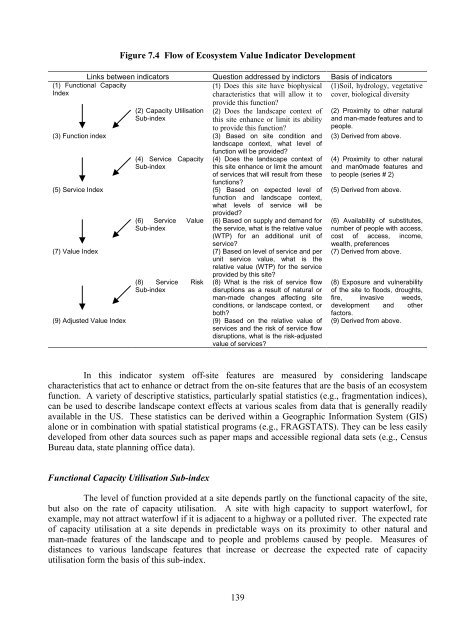Valuation of Biodiversity Benefits (OECD)
Valuation of Biodiversity Benefits (OECD)
Valuation of Biodiversity Benefits (OECD)
- No tags were found...
Create successful ePaper yourself
Turn your PDF publications into a flip-book with our unique Google optimized e-Paper software.
(1) Functional CapacityIndexFigure 7.4 Flow <strong>of</strong> Ecosystem Value Indicator DevelopmentLinks between indicators Question addressed by indictors Basis <strong>of</strong> indicators(1) Does this site have biophysicalcharacteristics that will allow it toprovide this function?(2) Capacity UtilisationSub-index(2) Does the landscape context <strong>of</strong>this site enhance or limit its abilityto provide this function?(3) Function index (3) Based on site condition andlandscape context, what level <strong>of</strong>function will be provided?(4) Service CapacitySub-index(4) Does the landscape context <strong>of</strong>this site enhance or limit the amount<strong>of</strong> services that will result from thesefunctions?(5) Service Index (5) Based on expected level <strong>of</strong>function and landscape context,what levels <strong>of</strong> service will beprovided?(6) Service ValueSub-index(6) Based on supply and demand forthe service, what is the relative value(WTP) for an additional unit <strong>of</strong>service?(7) Value Index (7) Based on level <strong>of</strong> service and perunit service value, what is therelative value (WTP) for the serviceprovided by this site?(8) Service RiskSub-index(8) What is the risk <strong>of</strong> service flowdisruptions as a result <strong>of</strong> natural orman-made changes affecting siteconditions, or landscape context, orboth?(9) Adjusted Value Index (9) Based on the relative value <strong>of</strong>services and the risk <strong>of</strong> service flowdisruptions, what is the risk-adjustedvalue <strong>of</strong> services?(1)Soil, hydrology, vegetativecover, biological diversity(2) Proximity to other naturaland man-made features and topeople.(3) Derived from above.(4) Proximity to other naturaland man0made features andto people (series # 2)(5) Derived from above.(6) Availability <strong>of</strong> substitutes,number <strong>of</strong> people with access,cost <strong>of</strong> access, income,wealth, preferences(7) Derived from above.(8) Exposure and vulnerability<strong>of</strong> the site to floods, droughts,fire, invasive weeds,development and otherfactors.(9) Derived from above.In this indicator system <strong>of</strong>f-site features are measured by considering landscapecharacteristics that act to enhance or detract from the on-site features that are the basis <strong>of</strong> an ecosystemfunction. A variety <strong>of</strong> descriptive statistics, particularly spatial statistics (e.g., fragmentation indices),can be used to describe landscape context effects at various scales from data that is generally readilyavailable in the US. These statistics can be derived within a Geographic Information System (GIS)alone or in combination with spatial statistical programs (e.g., FRAGSTATS). They can be less easilydeveloped from other data sources such as paper maps and accessible regional data sets (e.g., CensusBureau data, state planning <strong>of</strong>fice data).Functional Capacity Utilisation Sub-indexThe level <strong>of</strong> function provided at a site depends partly on the functional capacity <strong>of</strong> the site,but also on the rate <strong>of</strong> capacity utilisation. A site with high capacity to support waterfowl, forexample, may not attract waterfowl if it is adjacent to a highway or a polluted river. The expected rate<strong>of</strong> capacity utilisation at a site depends in predictable ways on its proximity to other natural andman-made features <strong>of</strong> the landscape and to people and problems caused by people. Measures <strong>of</strong>distances to various landscape features that increase or decrease the expected rate <strong>of</strong> capacityutilisation form the basis <strong>of</strong> this sub-index.139












